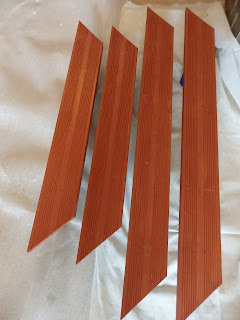Okay
so far? Good, we’ll move on to the next
part of the project and this is where it all starts to get a bit trickier.
 |
| Waterproofing your raised pond |
As
the raised pond is made of timber then to help it weather the elements and
extend the life of the structure it’s a good idea to give it a coat of
something waterproof such as Cuprinol or other outdoor paint/varnish. Apply as
per the instructions on the tin then leave to dry thoroughly.
 |
| Looks better now it's painted |
Once
assembled and painted, position your pond structure in what will be its final
resting place as the underlay and liner will be fitted in situ. It’s going to be a tight space to work in – note
to self; eat less cookies!
 |
| Putting the pond into its final position |
 |
| Not much space to work in |
To
create shelves for pond plants, I’ve placed a few leftover bricks on a layer of
sand sprinkled on top of the concrete base.
These are mostly at the back corners to raise any plants off the bottom.
 |
| Create submerged shelves for plants using bricks |
When
you have finished preparing the inside of your pond structure, it’s time to
think about lining the inside with special pond liner and underlay. I say ‘think’ because you really do need to
work out how to do this carefully before getting stuck in.
Pond
liner and underlay can be easily purchased online from many suppliers. I’m not going to give a lengthy explanation
as to all the different types of pond liner/underlay available or recommend a
specific type as there are loads to choose from. This is for you to research online and
purchase according to your preference or budget but I ended up getting mine
from www.pondkeeper.co.uk who provided free
underlay with the purchase of pond liner.
Most websites have a pond liner calculator so that you can work out how
much you need based on the dimensions of your pond.
 |
| Just one of many online suppliers |
 |
| There are lots of different types of liner or underlay |
The
underlay is a protective layer to ensure the pond liner is not punctured by any
sharp edges. The basic underlay I bought
was similar to a fabric type of weed membrane, soft and easy to fold into
place. Begin by laying out all of the
underlay on a flat surface so you can see the whole size/shape of it beforehand.
 |
| I was able to get a double layer of this in the pond it was so big |
I
found it easier to place the whole piece of underlay in the pond by folding the
fabric into thirds first with one section on top of the other. This underlay sandwich can then be carefully
placed into the pond structure and unfolded one layer at a time.
Make
sure the underlay lays flat on the bottom of the pond without being stretched
so that it doesn’t tear when you place the liner on top and fill with
water. There should be as few creases as
possible although with such a large piece of underlay I found it quite hard not
to fold it a million times especially in the corners where you need it to sit
quite flat.
 |
| Underlay carefully laid in position |
With
the underlay carefully laid in your pond, gently clamp to hold it in position whilst
you go off for a well-earned cup of tea.
Don’t worry about the overlapping fabric at the top edge as there’ll be
plenty of time to trim that later.

.JPG)
.JPG)



















.JPG)
.JPG)





























